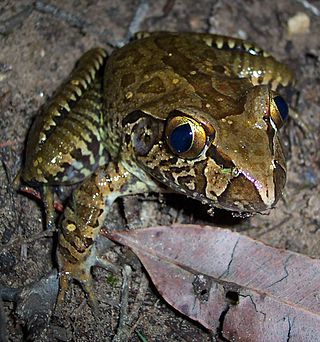
Conondale National Park is 130 km north of Brisbane in the Sunshine Coast Hinterland near the town of Conondale in the south east Queensland bioregion. The park covers an area of 35,648 hectares protecting large areas of subtropical rainforest, woodlands, wet and dry sclerophyll forest including Queensland's tallest tree. The park contains areas of regenerating forest which have been previously logged; areas of forest plantations also border the park. The park is currently managed by the Queensland Government under the Nature Conservation Act 1992.

The common yabby is an Australian freshwater crustacean in the Parastacidae family. It is listed as a vulnerable species of crayfish by the International Union for Conservation of Nature (IUCN), though the wild yabby populations remain strong, and have expanded into new habitats created by reservoirs and farm dams.

The Murray crayfish, Euastacus armatus, is a species of freshwater crayfish endemic to Australia that belongs to the family Parastacidae. The Murray crayfish has the largest geographic range of any of the Euastacus crayfish in Australia, being found in the Murray and Murrumbidgee Rivers as well as many of their tributaries. Murray crayfish are also known as "Murray River crayfish", "Murray crays", "freshwater crays", "spiny freshwater crays", "spinies" and in the Wagga Wagga region of southern New South Wales they are simply known as "lobsters".

Euastacus is a genus of freshwater crayfish known as "spiny crayfish". They are found in the south-east of the Australian mainland, along with another genus of crayfish, Cherax. Both genera are members of the family Parastacidae, a family of freshwater crayfish restricted to the Southern Hemisphere.
Euastacus bindal is a species of southern crawfish in the family Parastacidae.
Euastacus bispinosus, the Glenelg spiny crayfish, is a species of southern crawfish in the family Parastacidae.
Euastacus crassus is a species of southern crayfish in the family Parastacidae. It is commonly known as the Alpine spiny crayfish.
Euastacus diversus is a species of southern crawfish in the family Parastacidae.
Euastacus eungella is a species of southern crawfish in the family Parastacidae.
Euastacus fleckeri is a species of southern crawfish in the family Parastacidae.
Euastacus jagara is a species of Australian crayfish in the family Parastacidae. It is known from only six specimens, all collected at the type locality in the Mistake Mountains in the State of Queensland, Australia. The streams inhabited by the species are surrounded by Upland Subtropical Rainforest, and drain into the Brisbane River. The species is listed as critically endangered on the IUCN Red List.
Euastacus monteithorum is a species of southern crawfish in the family Parastacidae.
Euastacus neodiversus is a species of southern crawfish in the family Parastacidae.
Euastacus robertsi is a species of southern crawfish in the family Parastacidae.
Euastacus setosus is a species of southern crawfish in the family Parastacidae.
Euastacus urospinosus is a species of southern crawfish in the family Parastacidae.
Euastacus yigara is a species of southern crawfish in the family Parastacidae.

Euastacus spinifer is a species of freshwater crayfish endemic to Australia that belongs to the family Parastacidae.
Euastacus guruhgi is a species of freshwater crayfish found in the Australian state of New South Wales. It has an estimated extent of occurrence of 80 square kilometres (31 sq mi) and an area of occupancy of 7.5 square kilometres (2.9 sq mi) where it occurs fragmentedly. The species has been assessed as a critically endangered species due to a continuing decline in the quality of its habitat due to the invasive exotic species in the area, some of which predate upon this species. Furthermore, there is a continual destruction of its suitable rainforest habitat. E. guruhgi also faces the consequences of global warming; as a restricted range species, it is dependent on cool headwater streams and a slight increase in the temperature of the water could rapidly eradicate the species. There are no specific conservation measures for this species in place but the distribution range of the E. guruhgi falls within the Mount Warning and Wollumbin national parks. In New South Wales, there is a minimum recreational size limit of 90 mm orbital carpace length for any spiny crayfish. E. guruhgi does not attain that size, and is thus, indirectly protected by this restriction.
Euastacus dalagarbe is a species of freshwater crayfish endemic to Australia that belongs to the family Parastacidae. It has a small range in New South Wales and is regarded by the International Union for Conservation of Nature as "critically endangered".





